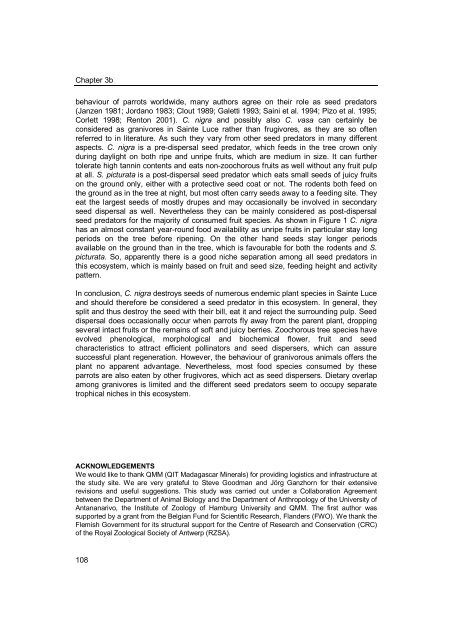Fruit-frugivore interactions in a Malagasy littoral forest - Universiteit ...
Fruit-frugivore interactions in a Malagasy littoral forest - Universiteit ...
Fruit-frugivore interactions in a Malagasy littoral forest - Universiteit ...
You also want an ePaper? Increase the reach of your titles
YUMPU automatically turns print PDFs into web optimized ePapers that Google loves.
Chapter 3b<br />
behaviour of parrots worldwide, many authors agree on their role as seed predators<br />
(Janzen 1981; Jordano 1983; Clout 1989; Galetti 1993; Sa<strong>in</strong>i et al. 1994; Pizo et al. 1995;<br />
Corlett 1998; Renton 2001). C. nigra and possibly also C. vasa can certa<strong>in</strong>ly be<br />
considered as granivores <strong>in</strong> Sa<strong>in</strong>te Luce rather than <strong>frugivore</strong>s, as they are so often<br />
referred to <strong>in</strong> literature. As such they vary from other seed predators <strong>in</strong> many different<br />
aspects. C. nigra is a pre-dispersal seed predator, which feeds <strong>in</strong> the tree crown only<br />
dur<strong>in</strong>g daylight on both ripe and unripe fruits, which are medium <strong>in</strong> size. It can further<br />
tolerate high tann<strong>in</strong> contents and eats non-zoochorous fruits as well without any fruit pulp<br />
at all. S. picturata is a post-dispersal seed predator which eats small seeds of juicy fruits<br />
on the ground only, either with a protective seed coat or not. The rodents both feed on<br />
the ground as <strong>in</strong> the tree at night, but most often carry seeds away to a feed<strong>in</strong>g site. They<br />
eat the largest seeds of mostly drupes and may occasionally be <strong>in</strong>volved <strong>in</strong> secondary<br />
seed dispersal as well. Nevertheless they can be ma<strong>in</strong>ly considered as post-dispersal<br />
seed predators for the majority of consumed fruit species. As shown <strong>in</strong> Figure 1 C. nigra<br />
has an almost constant year-round food availability as unripe fruits <strong>in</strong> particular stay long<br />
periods on the tree before ripen<strong>in</strong>g. On the other hand seeds stay longer periods<br />
available on the ground than <strong>in</strong> the tree, which is favourable for both the rodents and S.<br />
picturata. So, apparently there is a good niche separation among all seed predators <strong>in</strong><br />
this ecosystem, which is ma<strong>in</strong>ly based on fruit and seed size, feed<strong>in</strong>g height and activity<br />
pattern.<br />
In conclusion, C. nigra destroys seeds of numerous endemic plant species <strong>in</strong> Sa<strong>in</strong>te Luce<br />
and should therefore be considered a seed predator <strong>in</strong> this ecosystem. In general, they<br />
split and thus destroy the seed with their bill, eat it and reject the surround<strong>in</strong>g pulp. Seed<br />
dispersal does occasionally occur when parrots fly away from the parent plant, dropp<strong>in</strong>g<br />
several <strong>in</strong>tact fruits or the rema<strong>in</strong>s of soft and juicy berries. Zoochorous tree species have<br />
evolved phenological, morphological and biochemical flower, fruit and seed<br />
characteristics to attract efficient poll<strong>in</strong>ators and seed dispersers, which can assure<br />
successful plant regeneration. However, the behaviour of granivorous animals offers the<br />
plant no apparent advantage. Nevertheless, most food species consumed by these<br />
parrots are also eaten by other <strong>frugivore</strong>s, which act as seed dispersers. Dietary overlap<br />
among granivores is limited and the different seed predators seem to occupy separate<br />
trophical niches <strong>in</strong> this ecosystem.<br />
ACKNOWLEDGEMENTS<br />
We would like to thank QMM (QIT Madagascar M<strong>in</strong>erals) for provid<strong>in</strong>g logistics and <strong>in</strong>frastructure at<br />
the study site. We are very grateful to Steve Goodman and Jörg Ganzhorn for their extensive<br />
revisions and useful suggestions. This study was carried out under a Collaboration Agreement<br />
between the Department of Animal Biology and the Department of Anthropology of the University of<br />
Antananarivo, the Institute of Zoology of Hamburg University and QMM. The first author was<br />
supported by a grant from the Belgian Fund for Scientific Research, Flanders (FWO). We thank the<br />
Flemish Government for its structural support for the Centre of Research and Conservation (CRC)<br />
of the Royal Zoological Society of Antwerp (RZSA).<br />
108

















